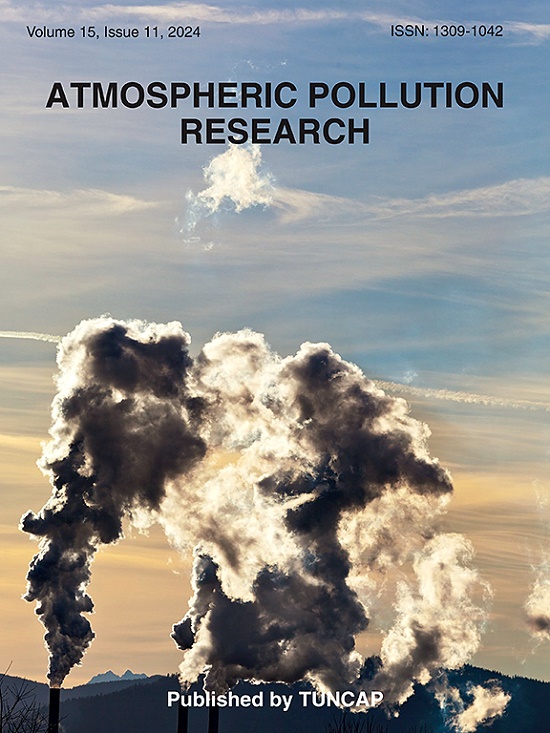南非城市和农村家庭PM2.5:使用低成本传感器的比较分析
IF 3.9
3区 环境科学与生态学
Q2 ENVIRONMENTAL SCIENCES
引用次数: 0
摘要
家庭空气污染每年造成数百万人过早死亡。在世界许多地方,特别是撒哈拉以南非洲,暴露于家庭空气污染物作为健康状况不佳的一个风险因素尚未得到充分量化。我们旨在评估南非城市(索韦托)和农村(阿金库尔)环境中的HAP,特别是PM2.5,及其与住宅和家庭特征的关系。我们在两个研究地点和季节使用低成本传感器监测了40个独特家庭的室内PM2.5浓度。通过配置校准低成本传感器,并使用对数线性回归模型评估住宅和家庭特征与室内PM2.5浓度之间的关系。城市家庭PM2.5浓度在夏季(50 μg/m3 (95% CI: 41-63)和冬季(82 μg/m3 (95% CI: 62-109))高于农村家庭(夏季:19 μg/m3 (95% CI: 14-26)和冬季:48 μg/m3 (95% CI: 44-53))。对数线性模型(n = 39)解释了留一交叉验证中74%的方差。观察到以下因素与家庭PM2.5的显著关联:季节、研究环境、是否吸烟、住宅内是否烧香以及暖气的使用。本研究发现,城市和农村社区内和社区间HAP浓度存在显著差异,可能受到室外环境浓度差异和个人行为(如烧香)的影响。提高社区和决策者对室内吸烟危害和室内烧香有害影响的认识至关重要。本文章由计算机程序翻译,如有差异,请以英文原文为准。

Household PM2.5 in a South African urban and rural setting: A comparative analysis using low-cost sensors
Household air pollution (HAP) is responsible for millions of premature deaths each year. Exposure to household air pollutants as a risk factor for poor health has not been adequately quantified in many parts of the world, especially Sub-Saharan Africa. We aimed to assess HAP, specifically PM2.5, and its associations with dwelling and household characteristics in urban (Soweto) and rural (Agincourt) settings in South Africa. We monitored indoor PM2.5 concentrations in 40 unique households using low-cost sensors, across two study sites and seasons. Low-cost sensors were calibrated by collocation, and associations between dwelling and household characteristics with indoor PM2.5 concentrations were assessed using a log-linear regression model. PM2.5 concentrations were greater in urban households in the summer (50 μg/m3 (95% CI: 41–63) and in the winter (82 μg/m3 (95% CI: 62–109)) compared to rural households (summer: 19 μg/m3 (95%: CI 14–26) and winter: 48 μg/m3 (95% CI: 44–53)). The log-linear model (n = 39) explained 74% of the variance in leave-one-out cross validation. Significant associations with household PM2.5 were observed with the following: the season, study setting, presence of tobacco smoking, presence of incense burning inside the dwelling, and the use of heating. This study found significant variations in HAP concentrations within and across the urban and rural communities, likely influenced by differences in ambient outdoor concentrations and individual behaviours such as incense burning. It is crucial to enhance community and policy maker awareness regarding the dangers of indoor smoking and the harmful effects of burning incense indoors.
求助全文
通过发布文献求助,成功后即可免费获取论文全文。
去求助
来源期刊

Atmospheric Pollution Research
ENVIRONMENTAL SCIENCES-
CiteScore
8.30
自引率
6.70%
发文量
256
审稿时长
36 days
期刊介绍:
Atmospheric Pollution Research (APR) is an international journal designed for the publication of articles on air pollution. Papers should present novel experimental results, theory and modeling of air pollution on local, regional, or global scales. Areas covered are research on inorganic, organic, and persistent organic air pollutants, air quality monitoring, air quality management, atmospheric dispersion and transport, air-surface (soil, water, and vegetation) exchange of pollutants, dry and wet deposition, indoor air quality, exposure assessment, health effects, satellite measurements, natural emissions, atmospheric chemistry, greenhouse gases, and effects on climate change.
 求助内容:
求助内容: 应助结果提醒方式:
应助结果提醒方式:


